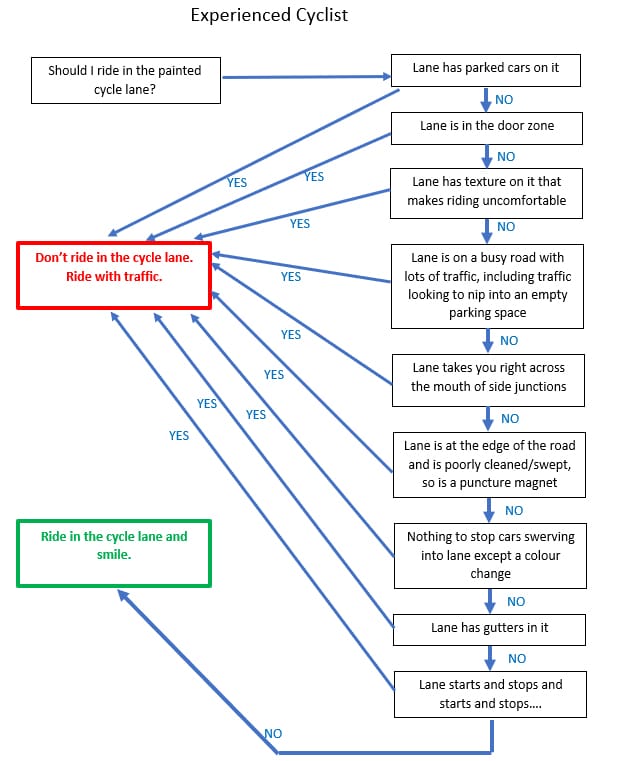Road Design Challenges for People on Bikes (3) – Non-Segregated Cycle Lanes
Non-segregated cycle lanes.
As the Strathclyde Cycle Campaign, GoBike has long been frustrated by substandard provision for active travel across our region. Despite campaigning for years against certain designs, we are continuing to see them used across road improvements and in newly funded projects
In the third of three blogs, our co-convenor Dave looks at non-segregated cycle lanes on the carriageway, and the dangers they create for people on bikes of all ages and abilities.
A large percentage of those who currently cycle will have read the top four words and will have cringed. Cycle lanes demarcated only by paint, different paving, or colour, are not particularly well loved among those who cycle regularly.
Are they unfairly maligned? Should we be thankful when the council paints some space for us on the road? Surely designating some space for cycling on the carriageway is better than not designating space at all?
Well no. Unfortunately not. And here are some of the many reasons why.

Compartment Effect
It has been shown that if you paint a lane on the road, and people on bikes use it, that drivers tend to drive past you more closely [1]. I myself have previously written about ‘compartment effect’ and the ‘negotiation effect’ of painted cycle lanes [2].
The compartment effect is where a driver sees a person on a bike in their ‘box’ and so feels a unjustified sense of security because everyone is in the correct compartment. So long as the driver stays within his box, and the person on a bike remains within their box, surely everyone will be happy? Unfortunately those boxes are only separated by a couple of centimetres of paint, which as many of us will be acutely aware, isn’t in any way protective.
Once in the lane and you are in the ‘correct’ box, you need to negotiate to get back out of it, a negotiation which would not be required had the lane not been there at all. Many drivers would be confused that you might want to get out of the lane. Why would you want to ‘leave the safety of the painted lane’?!
Obstructions
Why indeed….
That is all of course assuming that the cycle lane doesn’t have a car or six parked in it, meaning that the cycle lane is effectively a very narrow parking space and not a cycle lane at all!

Door Zone
Perhaps you are lucky today though and the lane ahead of you doesn’t have cars parked in it. Unfortunately it has cars parked right next to it. Often so close that if a door opened, which is what they are designed to do after all, it will fill up the whole cycle lane!

Maintenance
Even when there are no cars parked in it or cars parked right next to it, it is often poorly maintained. The problem is that the cycle lane, having decided to position itself at the very edge of the road, the very place where water is encouraged to flow towards the gutters, is usually full of mud, leaves, loose stones, broken glass, and as a result, punctured bike wheels.
It is the most neglected part of the carriageway because it is viewed by authorities as…...not actually being part of the carriageway.

So if cycle lanes can cause problems, can they ever be the right option? Yes they can, but not on busy roads. The example below [3] demonstrates that painted lanes can work, but only on quiet roads, where the car is ‘the guest’ rather than the norm.

Surely there must be times when a painted, on carriageway cycle lane can work on a busy urban road!? I always find that situations like this benefit from a little thought experiment. Just open your mind….
Thought Experiment
Let’s imagine we have three people. One is an experienced cyclist, one is a novice cyclist and one is a potential cyclist. Now let’s imagine a busy road. Lots or vehicles of all shapes and sizes. Let’s also imagine parking down both sides of this road. What would each of the above cyclists do in this situation if they came across a painted cycle lane ‘taking up space’ in the carriageway of this road?
Here is the thought process for the experienced cyclist.

Now the novice cyclist.

And now the potential cyclist.

Looking through it all logically, it doesn’t take much for an experienced cyclist to ignore a painted lane, for a novice cyclist to feel disenfranchised by a painted lane, and for the potential cyclist, to remain a potential cyclist and just forget about lanes all together.
Taking the logic to its conclusion, on the vast majority of urban roads, there is no longer a place for the painted lane. It is time for Scotland to embrace the lessons that have already been learned elsewhere and to build proper cycle infrastructure, which on busy urban roads means segregated cycle lanes, with protection from the surrounding motor traffic. Until then, the revolution will be limited.
[2] http://www.magnatom.net/2011/03/get-in-bloody-cycle-lane.html
[3]http://www.aviewfromthecyclepath.com/2014/04/on-road-cycle-lanes-good-bad-and-ugly.html





